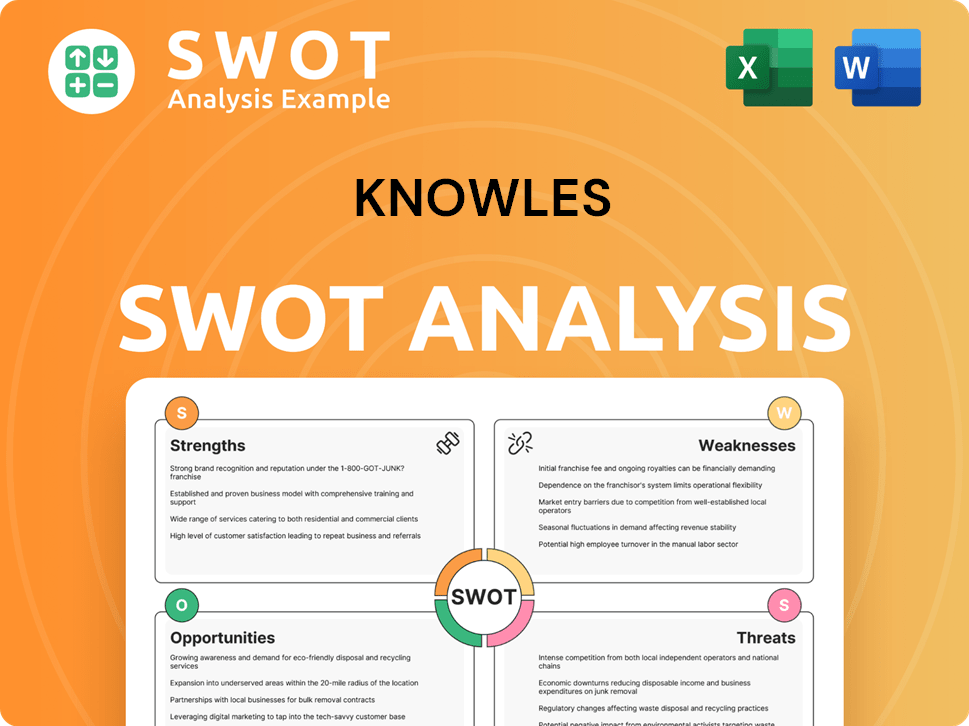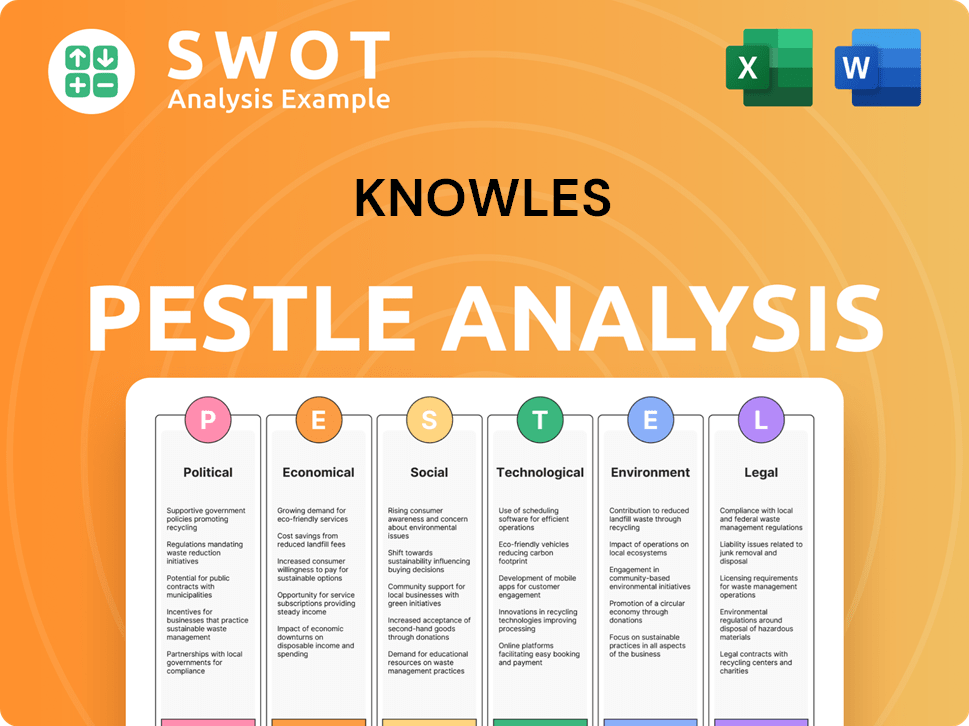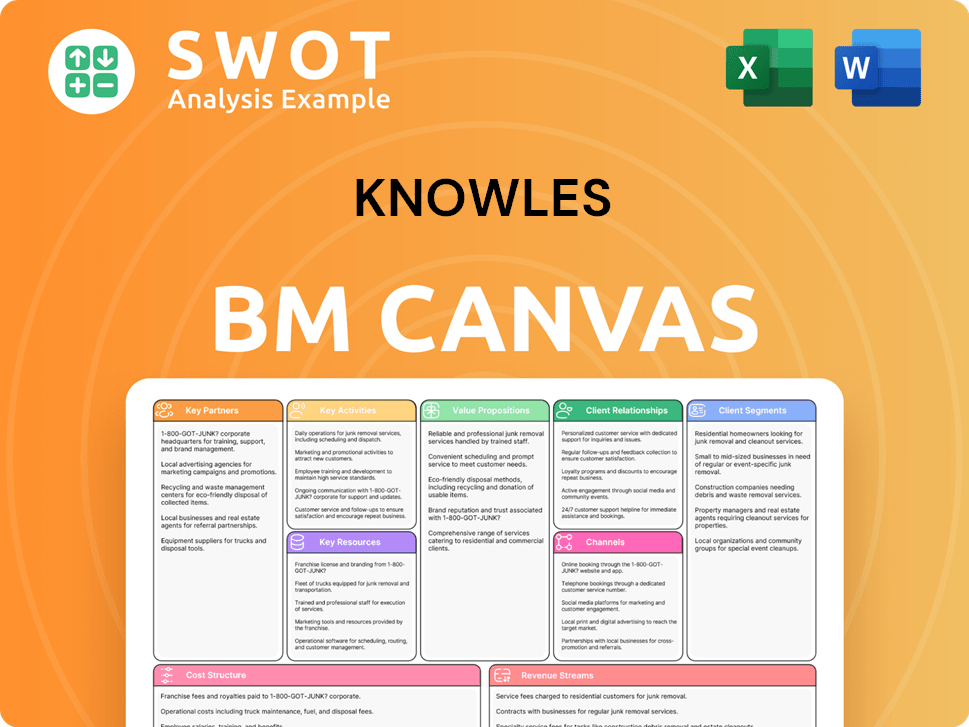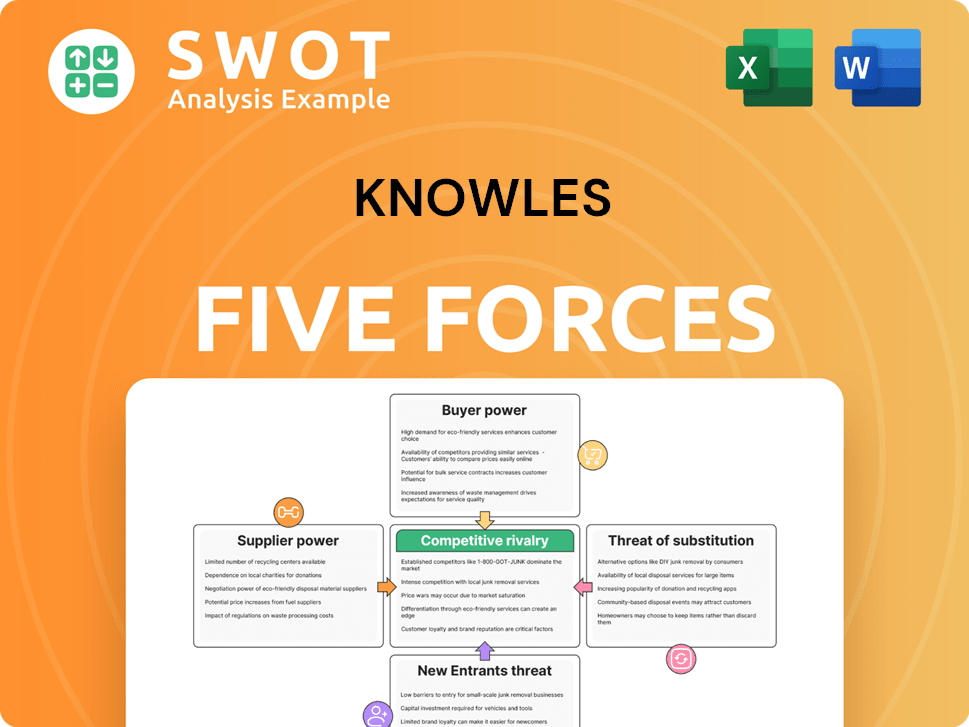Knowles Bundle
How has Knowles Company shaped the audio landscape?
Dive into the Knowles SWOT Analysis to understand the company's strategic position. From its humble beginnings in 1946, Knowles Corporation has dramatically influenced the evolution of audio technology. This brief history explores the remarkable journey of Knowles, a company that has consistently pushed the boundaries of what's possible in sound.

The Knowles history is a story of innovation, from its early years focusing on hearing aid technology to its current status as a global leader. Understanding the Knowles Company timeline reveals key milestones and the strategic decisions that have propelled its growth. Explore the impact of Knowles Corporation's innovations and its lasting legacy in the electronics industry.
What is the Knowles Founding Story?
The Knowles Corporation, a significant player in the micro-acoustics industry, traces its origins back to 1946. The story of the Knowles Company begins with a vision to revolutionize the hearing aid industry, driven by the innovative spirit of its founder, Hugh S. Knowles.
Hugh Knowles, an engineer with a background in acoustics, saw an opportunity to create smaller, more efficient components. This led to the development of miniature transducers, which were crucial for improving the size and functionality of hearing aids. This early focus on innovation set the stage for the Knowles Corporation's future.
The company's establishment was a response to the post-World War II era's technological advancements. The demand for improved medical devices, particularly those enhancing quality of life, played a crucial role in the company's early success. The Knowles history is a testament to the power of innovation and its impact on the electronics industry.
Hugh S. Knowles founded the company in Illinois in 1946, focusing on miniature transducers for the hearing aid market. The initial business model centered on designing and manufacturing these specialized components.
- The first product was a miniature magnetic microphone, a key innovation.
- This innovation enabled smaller, more effective hearing aids.
- The company capitalized on the growing demand for advanced medical devices.
- The post-war era provided a fertile ground for technological innovation.
The initial focus of Knowles products was on components for hearing aids. The development of a miniature magnetic microphone was a pivotal moment, enabling the creation of smaller and more effective hearing aids. This early success laid the groundwork for the company's expansion into other areas of micro-acoustics. The company's ability to identify and address market needs has been a constant throughout its history, as detailed in Revenue Streams & Business Model of Knowles.
While specific details about the company's initial funding are not widely publicized, Hugh Knowles's engineering expertise and entrepreneurial drive were instrumental in establishing the company. The company's early years were marked by a commitment to technological advancement and the development of specialized components, which set the stage for future growth. The company's commitment to innovation and its ability to adapt to market changes have been key to its longevity.
Knowles SWOT Analysis
- Complete SWOT Breakdown
- Fully Customizable
- Editable in Excel & Word
- Professional Formatting
- Investor-Ready Format

What Drove the Early Growth of Knowles?
The early growth of Knowles Corporation was significantly shaped by its pioneering work in miniature acoustic components. The introduction of its miniature magnetic microphone was a pivotal moment, paving the way for a range of transducers that set new standards in miniaturization and performance. This early focus solidified the company's position as a leader in precision acoustic solutions, marking a critical phase in the Knowles history.
Knowles Company initially catered to hearing aid manufacturers, who quickly recognized the superior quality and compact size of its components. This early success led to substantial sales growth and expansion within the medical device sector. The company's early facilities were likely in Illinois, where the Knowles founder established the initial operations.
Recognizing the broader applicability of its micro-acoustic technology, Knowles began to explore opportunities in other emerging electronics sectors. This included developing components for early communication devices and specialized industrial applications. The company's strategic foresight helped it enter new markets beyond hearing aids, a key element in the Knowles Company timeline.
The company's consistent innovation and market penetration during this period suggest a period of sustained organic growth and strategic investments to expand its technological capabilities and market reach. Leadership transitions likely focused on strengthening engineering and manufacturing capabilities to support its expanding operations and product lines. Further insights can be found in the Competitors Landscape of Knowles.
The market reception for Knowles products was largely positive, driven by the increasing demand for smaller and more efficient electronic devices. The competitive landscape, while present, was less saturated in the niche of high-precision miniature acoustics, allowing Knowles to establish a strong foothold. This positioning shaped its trajectory as a leading supplier of critical components.
Knowles PESTLE Analysis
- Covers All 6 PESTLE Categories
- No Research Needed – Save Hours of Work
- Built by Experts, Trusted by Consultants
- Instant Download, Ready to Use
- 100% Editable, Fully Customizable

What are the key Milestones in Knowles history?
The Knowles Corporation has a rich Knowles history, marked by significant achievements and strategic pivots. The Knowles Company has consistently adapted to industry changes, establishing itself as a key player in the audio and electronics sectors. The Knowles Company timeline reflects its evolution and impact on the industry.
| Year | Milestone |
|---|---|
| 2001 | Development of the first surface-mount MEMS microphone, revolutionizing the mobile electronics industry. |
| Ongoing | Securing numerous patents related to acoustic and precision device technologies, solidifying its intellectual property. |
| Ongoing | Establishing major partnerships with leading consumer electronics brands, cementing its position as a critical supplier. |
Knowles Corporation has been at the forefront of innovation. The company's focus on miniaturization and performance has driven its success. Its innovations have significantly impacted the consumer electronics market, improving audio quality and device design.
The development of MEMS microphones enabled smaller, more efficient audio solutions. This technology has been crucial for the advancement of smartphones and other portable devices. The company's commitment to research and development has kept it ahead of the curve.
Knowles products have included balanced armature speakers, which offer high-quality audio in compact designs. These speakers are widely used in hearing aids and premium audio products. The company continues to innovate in this area, improving sound quality and efficiency.
Knowles Company has expanded into advanced acoustic solutions, including noise cancellation and voice processing technologies. These technologies are increasingly important in a variety of applications, from consumer electronics to automotive systems. This strategic move reflects the company's adaptation to new market demands.
Knowles Company has played a key role in the miniaturization of electronics. The company's components have enabled smaller and more powerful devices. This trend is expected to continue, driving further innovation in the industry.
Knowles Corporation has been involved in the development of voice interface technologies, which are becoming increasingly prevalent. These technologies enhance user experience and open up new possibilities for device interaction. The company is well-positioned to capitalize on this trend.
Knowles Company has focused on high-performance audio solutions, catering to the premium market segment. This strategic focus on quality and performance has helped the company maintain its competitive edge. The company's emphasis on high-performance audio reflects its commitment to innovation.
Knowles Corporation has faced significant challenges in the electronics industry. Intense competition and market fluctuations have required strategic adjustments. The company has also navigated technological shifts and the need for continuous innovation.
The electronics market is highly competitive, with new entrants and established players constantly vying for market share. This competition has led to pricing pressures and the need for continuous innovation. Knowles Company must continually adapt to stay competitive.
Economic downturns can significantly impact the demand for consumer electronics, affecting Knowles Company's revenue. The company must manage its operations efficiently and diversify its product offerings. Adapting to market volatility is crucial for long-term success.
Rapid technological changes require Knowles Corporation to continuously innovate and adapt its product portfolio. The company must invest in R&D to stay ahead of the curve. Adapting to new technologies is critical for maintaining market relevance.
Product failures or design challenges can require significant R&D investment and strategic pivots. Successfully navigating these challenges is essential for maintaining customer trust and market position. The company's ability to overcome these issues is a testament to its resilience.
Knowles Company has undertaken restructuring efforts, such as divesting non-core businesses to focus on high-growth segments. Rebranding initiatives and leadership changes have also been employed to adapt to market demands. These strategic shifts reflect the company's commitment to long-term growth.
The company must adapt to the increasing demand for integrated audio solutions. This requires continuous innovation and strategic repositioning. Knowles Corporation is committed to meeting the evolving needs of its customers.
Knowles Business Model Canvas
- Complete 9-Block Business Model Canvas
- Effortlessly Communicate Your Business Strategy
- Investor-Ready BMC Format
- 100% Editable and Customizable
- Clear and Structured Layout

What is the Timeline of Key Events for Knowles?
The Knowles history is marked by significant technological advancements and strategic shifts that have shaped its trajectory in the electronics industry. Founded in 1946 by Hugh S. Knowles, the company initially focused on miniature transducers for hearing aids before expanding its product line. A pivotal moment came in 2001 with the introduction of the first surface-mount MEMS microphone, revolutionizing mobile consumer electronics. The 2000s saw substantial growth driven by the mobile phone market, followed by a spin-off from Dover Corporation in 2014, which established it as an independent publicly traded company. Strategic acquisitions between 2015 and 2019 expanded its capabilities. The company continues to focus on high-performance audio solutions and is investing in advanced voice applications and edge processing. The company's journey demonstrates its adaptation and innovation in the dynamic technology landscape.
| Year | Key Event |
|---|---|
| 1946 | Hugh S. Knowles founded the company in Illinois, initially focusing on miniature transducers for hearing aids. |
| 1950s-1960s | The company expanded its product line to include a broader range of miniature acoustic components. |
| 2001 | Introduced the first surface-mount MEMS microphone, which transformed mobile consumer electronics. |
| 2000s | Experienced significant growth driven by the demand for MEMS microphones in the mobile phone market. |
| 2014 | Spun off from Dover Corporation, becoming an independent publicly traded company. |
| 2015-2019 | Made strategic acquisitions to broaden its capabilities in audio processing and intelligent audio solutions. |
| 2020 | Continued to focus on high-performance audio solutions for premium consumer electronics and medical markets. |
| 2022 | Announced new product developments targeting advanced voice applications and edge processing. |
| 2024 | Reported strong financial performance in its Precision Devices and Medtech segments, showing ongoing diversification. |
| 2025 | Continues investment in R&D for next-generation audio solutions and AI-enabled voice processing. |
Looking ahead, the company is positioned for continued growth. This includes high-performance audio, AI integration, and precision devices for specialized markets. The company is expanding its presence in the medical and defense sectors.
The company is heavily invested in developing advanced voice processing algorithms and AI-enabled solutions. These innovations are designed to enhance user experiences in smart devices and hearables. This is part of the company's long-term strategy.
The increasing demand for immersive audio and voice-controlled interfaces will significantly impact the company's future. The continued miniaturization of electronics is also a key factor. The company is well-positioned to capitalize on these trends.
The global MEMS microphone market, crucial for the company, is expected to grow. This growth is driven by the adoption of smart devices and IoT applications. The company aims to maintain its leadership in advanced acoustic solutions.
Knowles Porter's Five Forces Analysis
- Covers All 5 Competitive Forces in Detail
- Structured for Consultants, Students, and Founders
- 100% Editable in Microsoft Word & Excel
- Instant Digital Download – Use Immediately
- Compatible with Mac & PC – Fully Unlocked

Related Blogs
- What is Competitive Landscape of Knowles Company?
- What is Growth Strategy and Future Prospects of Knowles Company?
- How Does Knowles Company Work?
- What is Sales and Marketing Strategy of Knowles Company?
- What is Brief History of Knowles Company?
- Who Owns Knowles Company?
- What is Customer Demographics and Target Market of Knowles Company?
Disclaimer
All information, articles, and product details provided on this website are for general informational and educational purposes only. We do not claim any ownership over, nor do we intend to infringe upon, any trademarks, copyrights, logos, brand names, or other intellectual property mentioned or depicted on this site. Such intellectual property remains the property of its respective owners, and any references here are made solely for identification or informational purposes, without implying any affiliation, endorsement, or partnership.
We make no representations or warranties, express or implied, regarding the accuracy, completeness, or suitability of any content or products presented. Nothing on this website should be construed as legal, tax, investment, financial, medical, or other professional advice. In addition, no part of this site—including articles or product references—constitutes a solicitation, recommendation, endorsement, advertisement, or offer to buy or sell any securities, franchises, or other financial instruments, particularly in jurisdictions where such activity would be unlawful.
All content is of a general nature and may not address the specific circumstances of any individual or entity. It is not a substitute for professional advice or services. Any actions you take based on the information provided here are strictly at your own risk. You accept full responsibility for any decisions or outcomes arising from your use of this website and agree to release us from any liability in connection with your use of, or reliance upon, the content or products found herein.